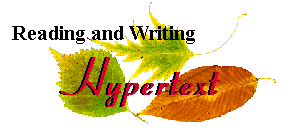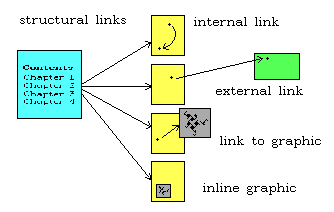

In this document I introduce a basic rhetoric of hypertext. After an opening section in which I delimit and describe the kind of hypertext I am discussing, I outline the primary features of the parts of a hypertext (the nodes) and the connections between them (the links). I conclude with some provisional criticisms of hypertext as a medium for communication.
After the table of contents, the structure of the document consists of a series of paragraphs with annotations to the right. The links offered in the right-hand column lead to examples (both local and external) or to more detailed discussions of an issue. The numbers in the left-hand column are internal reference points, to which links may be pointed from outside the document (e.g., if you wanted to create a pointer to paragraph 5, the last part of the URL would read: hypread.htm#05).
Description: types of hypertext | literary vs. non-literary | nodes | links
Criticism: surfing | fluidity | spatiality | interaction | education
Writing: your turn
| #01 | Types of hypertextDocument structure. A basic difference is between documents that are prestructured (for example, with a table of contents), in contrast to those that are self-navigating. A prestructured hypertext imitates the design of a book with chapters, perhaps with subdivisions within each chapter, etc., and could be seen graphically as a tree diagram. The self-navigating, once you have moved past the opening, depends on links embedded within the text. Since there may be more than one link,
| Prestructured: see my essay on computers and literature. Self-navigating: see Kaplan's essay on hypertext and ethics. |
| #02 | Thus in a self-navigating hypertext, the order in which you visit the nodes or lexia (terms for the separate sections of text) is determined by you, the reader. There is no overall logical order; links can be circular, recursive, or multiply related. This is the postmodern image of intertextuality. It may generate the anxiety of completeness: i.e., have I seen everything? Some authors help to allay this by providing a list of nodes somewhere, which as you visit them are given a different colour by the browser. |
|
| #03 | In the self-navigating hypertext, text is presented as short sections, or nodes, not in the form of a continuous, linear essay. Thus the nodes (as I will call them) must have some degree of self-sufficiency: each should make a coherent point or raise an intelligible issue. (I am discussing only text here: I don't refer to other forms of presentation such as an image map, table, diagram, chronology, etc., each of which has its virtues in supporting self-navigating hypertext. Incidentally, the body of this document is presented in a table with three columns.) | |
| #04 | Literary vs. non-literary hypertextThis distinction may be illegitimate, if you accept recent arguments about
the nature of text. In practice the distinction is often ignored, e.g.,
by Landow, where critical commentary and primary text are treated as if
they were the same thing in a hypertext system. But it seems likely that
different texts elicit different strategies in reading: critical or expository
prose calls for model building (Johnson-Laird); in contrast, a literary
text such as a novel or a poem invites an experiential and affective response.
A part of this is an anticipatory sense for the text that helps to guide
and shape the response to it (see Olson, et al., 1981). | recent arguments: see our paper (Miall and Kuiken) on forms of reading. P. N. Johnson-Laird, Mental Models (Cambridge, 1983). G. M. Olson, et al., "Cognitive Aspects of Genre," Poetics 10 (1981), 283-315. |
| #05 | NodesThe sections described below are standard parts of a traditional essay; but they can also have an important function within a hypertext, whether in framing the discourse that it offers, or conveying the argument. Types of node:
Location:
External links are analogous to footnotes in an academic paper: you signal the authors you have been reading and/or have quoted from. If the other authors are available online, the reader can go and read their writing in full for themselves (whereas with a conventional print essay you are less likely to go to the trouble of following up a footnote). This is similar to the "docuverse" concept of Paul Delany. | Examples from my Mariner essay
(on this server)
|
| #06 | LinksTypes of link:

| Examples:
|
| #07 | Forward and Backward links -- in fact, a system such as the browser you are now using treats these as equivalent: all is reversible in the space-time of hypertext. In this respect hypertext doesn't correspond to actual physical or psychological systems (the entropy, or non-reversible change, of most natural systems, etc.), including the act of literary reading -- but no forward-only systems exist, as far as I know (and these would be against the spirit of the new rhetoric). In reading literary texts, non-reversible transformations take place across the course of the text; a feeling or a realization made during reading cannot be unmade. One cannot begin reading the text over again and repeat the same experience. The linear nature of reading thus cannot be jettisoned without certain consequences. | reversible: see Martin E. Rosenberg, "Physics and Hypertext: Liberation and Complicity in Art and Pedagogy," in George P. Landow, ed., Hyper / Text / Theory (Baltimore: John Hopkins University Press, 1994), especially, pp. 277-8. |
| #08 | Movement:
Another way of thinking about the directionality of links, but now in explicitly spatial terms:
| |
| #09 | Placement: | |
| #10 | Rhetoric of departure / of arrivalWill the destination make sense to readers when they click the link and find themselves somewhere else? How much advance warning can you provide of what to expect at the other end of the link? (Netscape doesn't even distinguish between local and remote links.) Or do you want to surprise the reader? Stuart Moulthrop does. Postmodern writers celebrate the gap, the jump, the bricolage of hypertext, its unexpectedness. Some hypertext programs facilitate understanding of a link. Hyperties, for example, allows a one sentence advance organizer to appear on screen before you click to activate the link; HyperWriter and Netscape don't. |
For a literary example of the postmodern, see Stuart Moulthrop's fiction Hegirascope. You'll be surprised! |
| #11 | For a more elaborate account of the "rules" of hypertext see Landow (1991). He introduces the essential issues in this way:
|
my potted summary of Landow (1991) |
| #12 | SurfingLink distractability: i.e., the surfing syndrome -- the grass is alway greener on the other side of the link. As I have put it elsewhere, hypertext invites a mode of reading that is unsettled, restless, meandering, insatiable. Internet readers are surfers. Is this how reading is, or how it must become in the electronic future? | elsewhere: more on hypertext and reading |
| #13 | FluidityWords, once they are printed on a page, cannot but remain fixed and static. Not so with electronic text. Anyone who uses a word processor knows how malleable text can be: deleting, cutting and pasting, relocating whole paragraphs. Similarly, documents in a hypertext such as the internet can be changed as easily by their authors. Another kind of fluidity is given by the multiplicity of links available at any given point: readers can take different possible pathways through the nodes. This fluidity of the word changes the nature of writing:
Is a literary experience still possible, if the nodes of a text can be read in any different order and if the text itself is subject to change? Does this call for a kind of attention which is different from that we give to the literary? As Hassan notes, the literary is destabilized, unmargined: Without formal or generic constraints, our ability to make specific sense of literature diminishes even as our freedom, as readers, swells. (Hassan, p. 201) | Jay David Bolter, Writing Space: The Computer, Hypertext, and the History of Writing (Erlbaum, 1991)
Ihab Hassan, The Postmodern Turn (Ohio State UP, 1987) |
| #14 | SpatialityA spatial universe seems inescapable (e.g., Bolter's "writing space"): geometric metaphors abound in accounts of hypertext, as though what cannot be realized in spatial terms doesn't count. Moreover, there is a danger that the transfer of the non-spatial to hypertext tends to spatialize and hence diminish it. Coleridge: Under that despotism of the eye . . . under this strong sensuous influence, we are restless because invisible things are not the objects of vision; and metaphysical systems, for the most part, become popular, not for their truth, but in proportion as they attribute to causes a susceptibility of being seen, if only our visual organs were sufficiently powerful. (Biographia Literaria (1817), Ch. 6) While it doesn't follow that any text on the internet necessarily degrades the non-spatial, the graphical interface, the presence of links (quick: click 'em), and the narrowness of the screen, each tend to encourage a short attention span and a form of writing that calls for the tangible, immediate, and vivid. Can you get subtle on the net? Yes, of course: but, notice that those who do tend to write long, linear essays. Nice to have them available, but is this really where you want to do your serious reading? |
linear essays: see, for instance, this internet journal (one of many), Romanticism on the Net. My favourite reading -- but is it any different from a printed journal? |
| #15 | InteractionIs interaction limited merely to choosing links? Is this empowering? Only if you become a hypertext author yourself. And for the reader on the web, current tools don't allow for genuine interaction, not even highlighting, notetaking, annotation, or marginalia (what would Coleridge have done?). Compare this to reading a book (that you own, preferably). In which kind of reading are you more active? Recent hypertext rhetoric is dismissive of the book. | dismissive: e.g., Patrick Conner, "Hypertext in the Last Days of the Book," Bulletin of the John Rylands University Library of Manchester, 74 (1992), 7-24. |
| #16 | EducationA specific case of interactivity. Does it favour the transmission model of learning or a creative model? If hypertext is used merely as a medium to present information, then the authority of the medium must outweigh that of the student, just as textbooks, teachers, school timetables, and education boards have always done. Extending the hypertext available to include the internet is a difference in degree, not in kind: more of the same will not end in giving control over knowledge to the student. Let the student be an author in her own learning, then the hypertext tool offers a different potential. Students can either author their own hypertexts, or a teacher can use hypertext as a medium to report work that students have done. |
student authors: see projects done for a Romanticism course
|
Writing for the internet has become a lot easier with a tool such as Dreamweaver.
You'll still have to find a server for your web site (whether at the University
of Alberta, or through an internet service provider), but at least you could
try out for yourself the new hypertext rhetoric required by the net. Can you
make it work for you?

Last updated Sunday, August 8th 1999 / revised version November 5th 2007